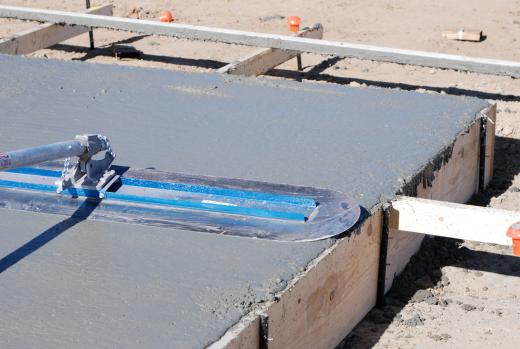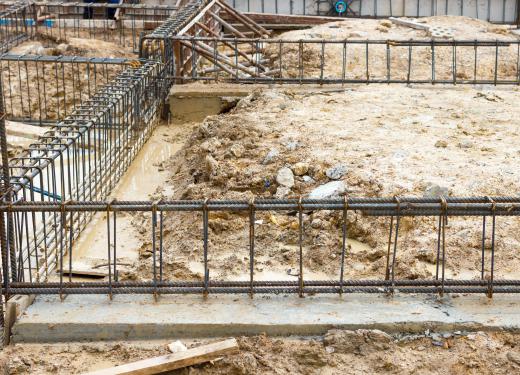A slab foundation is a layer of concrete, generally poured out over a prepared surface of soil or gravel, upon which a house or other structure is built. More appropriate to climates where ground freezing and thawing, and the associated soil movement, are not of particular concern, slab foundations are nevertheless anchored into the ground securely to prevent structural damage from environmental causes such as severe weather or shifting of the soil. While a structure built on a slab foundation has no “below grade” space that can be used for residential or storage purposes, it's generally much less costly to build than a comparable structure with a basement.
Beside providing a stable, flat, and level surface for occupants, a slab's purpose is to distribute much of the weight that's placed upon it. For example, many walls are “load bearing,” and without a foundation of some sort to rest upon, would not only sink into the soil to some extent, but would also respond to the soil's every movement. This is one reason that the soil underneath slab-type foundations must be prepared before the concrete is poured. For example, the soil will usually be leveled and overlaid with gravel and moisture barriers. The thickness of the foundation is calculated based upon a number of factors, including the anticipated load the slab will bear.

Another critical element of slab construction is footings — “anchors” of concrete poured into holes dug in the ground for that purpose. When the foundation is poured, it either rests on these anchors or is attached to them by means of rebar, reinforcing bars made of steel that are sunk into the footings while they're still wet, providing a high degree of stability for the slab foundation.

The main benefit of slab-type foundations is cost; a slab is the least costly foundation option available. There are many drawbacks to a slab foundation, though, especially in residential construction. For instance, a slab puts a great deal of stress on the legs, feet, and backs of the inhabitants when they walk on the ground floor. Even with carpeting, much of the shock of every step taken is absorbed by the skeleton and not the floor. Heating costs in slab-foundation houses are generally higher also, because so much cold comes into the house through the floor. Plumbing and electrical lines are either run down through the slab, making access difficult, or must be run out a wall, incurring added costs of securing and weatherizing.
Another significant drawback of a slab foundation is that space must be given over to appliances that would normally be maintained in a basement, such as hot water heaters, furnaces, and HVAC equipment.
